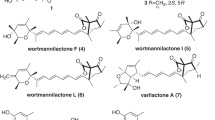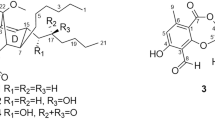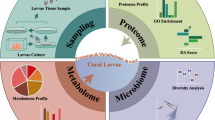Abstract
Two new polyketides, 6,8,5′6′-tetrahydroxy-3′-methylflavone (1) and paecilin C (2), together with six known analogs secalonic acid D (3), secalonic acid B (4) penicillixanthone A (5), emodin (6), citreorosein (7) and isorhodoptilometrin (8) were obtained from a broth of gorgonian coral-associated fungus Penicillium sp. SCSGAF 0023. Compounds 1 and 6–8 had significant antifouling activity against Balanus amphitrite larvae settlement with EC50 values of 6.7, 6.1, 17.9 and 13.7 μg ml−1, respectively, and 3–5 showed medium antibacterial activity against four tested bacterial strains. This was the first report of antibacterial activity of 3–5 against marine bacteria and antifouling activity of 6–8 against marine biofouling organism’s larvae. The results indicated that gorgonian coral-associated fungus Penicillium sp. SCSGAF 0023 strain could produce antifouling and antibacterial compounds that might aid the host gorgonian coral in protection against marine pathogen bacteria, biofouling organisms and other intruders.
Similar content being viewed by others
Log in or create a free account to read this content
Gain free access to this article, as well as selected content from this journal and more on nature.com
or
Accession codes
References
Coil, J. C. The chemistry and chemical ecology of octocorals (Coelenterata, Anthozoa, Octocorallia). Chem. Rev. 92, 613–631 (1992).
Harvell, C. D. et al. Emerging marine diseases-climate links and anthropogenic factors. Science 285, 1505–1510 (1999).
Shnit-Orland, M. & Kushmaro, A. Coral mucus-associated bacteria: a possible first line of defense. FEMS Microbiol. Ecol. 67, 371–380 (2009).
Zuluaga-Montero, A., Toledo-Hernández, C., Rodríguez, J. A., Sabat, A. M. & Bayman, P. Spatial variation in fungal communities isolated from healthy and diseased sea fans Gorgonia ventalina and seawater. Aquatic. Biology 8, 151–160 (2010).
Wang, Y. N., Shao, C. L., Zheng, C. J., Chen, Y. Y. & Wang, C. Y. Diversity and antibacterial activities of fungi derived from the gorgonian Echinogorgia rebekka from the South China Sea. Mar. Drugs 9, 1379–1390 (2011).
Steyn, P. S. Isolation, structure and absolute configuration of secalonic acid D, toxic metabolite of Penicillium oxalicum. Tetrahedron 26, 51–57 (1970).
Zhang, C. N. et al. Bioassay-guided separation of citreorosein and other oestrogenic compounds from Polygonum cuspidatum. Phytother. Res. 23, 740–741 (2009).
Jiang, T. et al. Chemical constituents from marine fungus penicillium thomii. Acta Pharm. Sinica 37, 271–274 (2002).
Wen, L. et al. Studies on the secondary metabolites and bioactivity of mangrove endophytic fungus Paecilomyces sp.(tree1-7). Chem. Res. Appl. 21, 198–202 (2009).
Kalidhar, S. B. Structural elucidation in anthraquinones using proton NMR glycosylation and alkylation shifts. Phytochemistry 28, 3459–3463 (1989).
Ren, H., Cao, X. L. & Gu, Q. Q. Antitumor metabolites from marine-derived fungus Gliocladium catenulatum T31. Chin. Pharm. J. 45, 1720–1723 (2010).
Shen, C. C., Chang, Y. S. & Ho, L. K. Nuclear magnetic resonance studies of 5,7-dihydroxyflavoids. Phytochemistry 34, 843–845 (1993).
Stochmal, A. et al. Alfalfa (Medicago sativa L.) flavonoids. 1. Apigenin and luteolin glycosides from aerial parts. J. Agric. Food Chem. 49, 753–758 (2001).
Horie, T., Tominaga, H. & Kawamura, Y. Revised structure of a natural flavone from Ageratum conyzoides. Phytochemistry 32, 1076–1077 (1993).
Nishikawa, K. et al. Flavone production in transformed root cultures of Scutellaria baicalensis Georgi. Phytochemistry 52, 885–890 (1999).
Guo, Z. et al. 1H and 13C NMR signal assignments of paecilin A and B, two new chromone derivatives from mangrove endophytic fungus Paecilomyces sp (tree 1-7). Mag. Reson. Chem. 45, 777–780 (2007).
Ren, H., Tian, L., Gu, Q. Q. & Zhu, W. M. Secalonic acid D; A cytotoxic constituent from marine lichen-derived fungus Gliocladium sp T31. Arch. Pharm. Res. 29, 59–63 (2006).
Millot, M., Tomasi, S., Studzinska, E., Rouaud, I. & Boustie, J. Cytotoxic constituents of the Lichen Diploicia canescens. J. Nat. Prod. 72, 2177–2180 (2009).
Reddy, R. V., Eldeib, M. M. & Reddy, C. S. Inhibition of adenylate cyclase in perfusion mouse palate by secalonic acid D. J. Toxicol. Env. Heal 41, 175–185 (1994).
Vesely, D., Vesela, D. & Jelinek, R. Embryotoxicity of T2 toxin and secalonic acid in embryonic chicks varies with the site of administration. Teratology 46, 131–1361 (1992).
Zhou, X. J. et al. Flavone and isoflavone derivatives of terrestrial plants as larval settlement inhibitors of the barnacle Balanus amphitrite. Biofouling 25, 69–76 (2009).
Qian, P. Y., Xu, Y. & Fusetani, N. Natural products as antifouling compounds: recent progress and future perspectives. Biofouling 26, 223–234 (2010).
Lai, X. T. et al. Fungal communities from methane hydrate-bearing deep-sea marine sediments in South China Sea. ISME J. 1, 756–762 (2007).
Liang, Y. L. et al. Pellicle formation in Shewanella oneidensis. BMC Microbiol. 10, 291 (2010).
Qi, S. H., Zhang, S., Qian, P. Y., Xiao, Z. H. & Li, M. Y. Ten new antifouling briarane diterpenoids from the South China Sea gorgonian Junceella juncea. Tetrahedron 62, 9123–9130 (2006).
Acknowledgements
We are grateful to the National Basic Research Program of China (grant 2010CB833803), the National Natural Science Foundation of China (grant 40931160435, 40976090), the Research Supported by the CAS/SAFEA International Partnership Program for Creative Research Teams (grant KZCX2-YW-T001) and the Knowledge Innovation Program of Chinese Academy of Science (grant KSCX2-EW-G-12B) for financial support.
Author information
Authors and Affiliations
Corresponding author
Ethics declarations
Competing interests
The authors declare no conflict of interest.
Additional information
Supplementary Information accompanies the paper on The Journal of Antibiotics website
Supplementary information
Rights and permissions
About this article
Cite this article
Bao, J., Sun, YL., Zhang, XY. et al. Antifouling and antibacterial polyketides from marine gorgonian coral-associated fungus Penicillium sp. SCSGAF 0023. J Antibiot 66, 219–223 (2013). https://doi.org/10.1038/ja.2012.110
Received:
Revised:
Accepted:
Published:
Issue date:
DOI: https://doi.org/10.1038/ja.2012.110
Keywords
This article is cited by
-
Antimicrobial polyketides from Magellan Seamount-derived fungus Talaromyces scorteus AS-242
The Journal of Antibiotics (2023)
-
Anti-neuroinflammatory effect of oxaline, isorhodoptilometrin, and 5-hydroxy-7-(2′-hydroxypropyl)-2-methyl-chromone obtained from the marine fungal strain Penicillium oxalicum CLC-MF05
Archives of Pharmacal Research (2022)
-
Bioactive Indole Diterpenoids and Polyketides from the Marine-Derived Fungus Penicillium javanicum
Chemistry of Natural Compounds (2020)
-
Recycling of Chinese herb residues by endophytic and probiotic fungus Aspergillus cristatus CB10002 for the production of medicinal valuable anthraquinones
Microbial Cell Factories (2019)
-
Biodiversity and antifouling activity of fungi associated with two soft corals from the South China Sea
Archives of Microbiology (2019)



